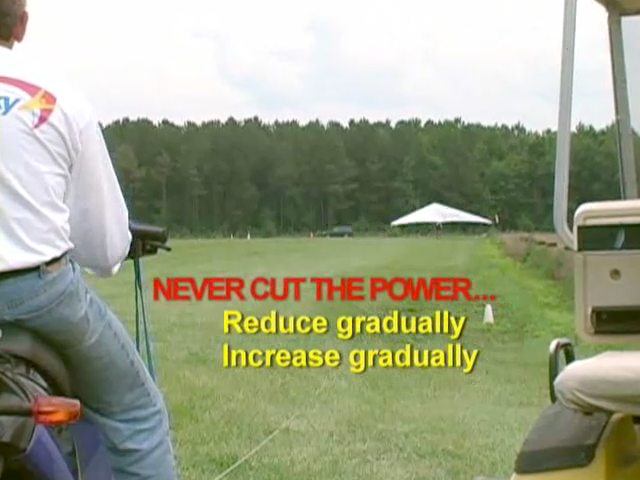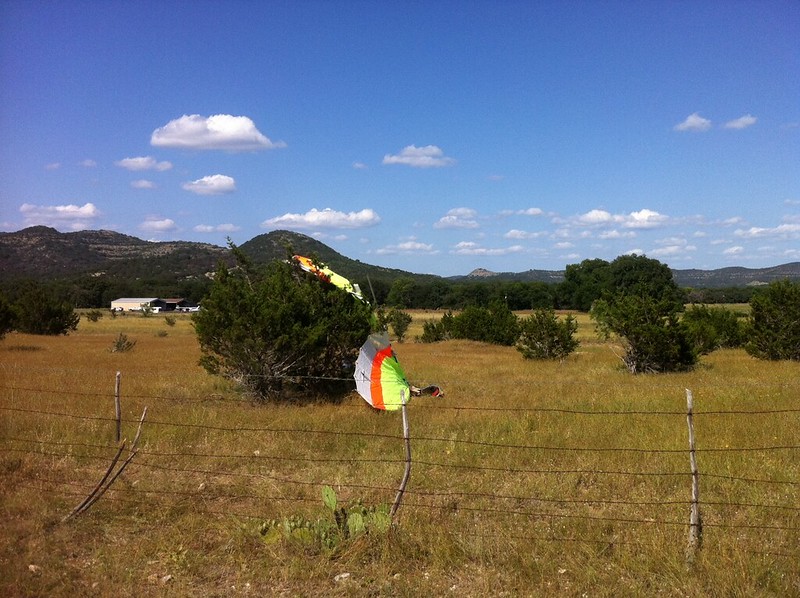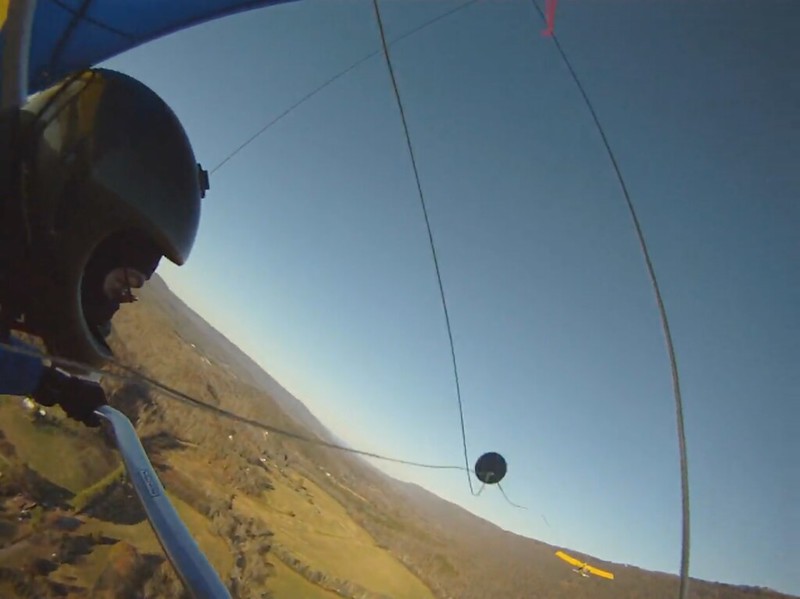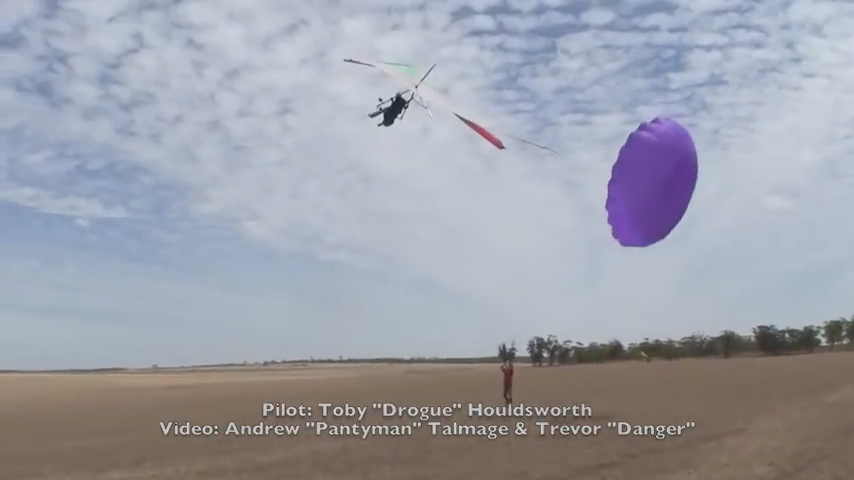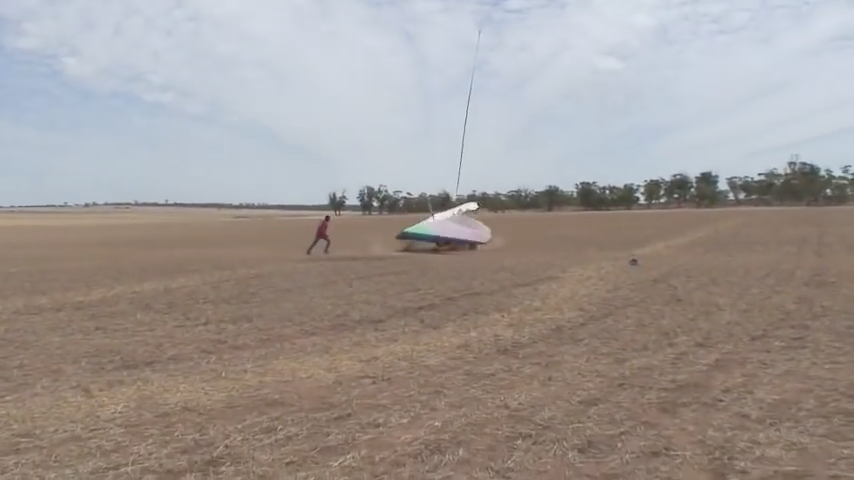weak links
Based on several decades of experience and hundreds of thousands of tows conducted by numerous aerotow operators across the county, the de facto standard has become use of a 260 pound weak link made as a loop of 130 pound Greenspot IGFA Dacron braided fishing line attached to one end of the pilot's V-bridle. It is a de facto standard, because it works for most pilots and gliders and is usually near the USHPA recommendation of a nominal one G weak link for most pilots.Zack C - 2012/08/17 21:09:03 UTC
Paul (pjwings, that is),
I think you have the right general idea, but I have to correct and clarify some things. I say 'think' because I can only speak for the side I'm on. I have a hard time getting the other side to tell me when a weak link should break or what its breaking strength should be (as you might have been able to tell).
The expectation of performance is that they break as early as possible in lockout situations, but be strong and reliable enough to avoid frequent weak link breaks from turbulence. It is the same expectation of performance that is had for the weak links used for towing sailplanes.
I don't know how much more clearly this can be stated.
Stronger weak links will still break during a lockout if the pilot doesn't release. It will just take slightly longer.Weak links should break during lockout...
VERY slightly in a rapidly progressing lockout.Antoine Saraf - 2012/05/25 19:45:39 UTC
I miss opportunity to be aerotowed in my mountains but 2 months ago we spent 4 days teaching AT to 12 pilots in 2 points. All had 190kg weaklink (220kg on tug side).
One of them oscillate and start to lockout. I said by radio : (time to) release, he did it (JoeStreet release), but 1ms to late.. the weaklink was just blowed.
and no unexpected wl failure in 90 AT.
I'm confident in this way to think wl..
But if you're flying an Industry Standard release you don't want the towline tension to be allowed to exceed about 200 pounds.I wouldn't say 'about to fail'...they should break well below that to leave a safe margin. I'd say they should break well above anything that would normally be encountered on tow but well below what would break the aircraft. That allows a pretty big range.Weak links should never break unless the glider and/or tug is about to fail structurally.
Very expensive inconveniences - even if you don't trash a downtube.Weak link breaks are usually nothing more than inconveniences.This is because a weak link that is any weaker may break at random, unpredictable times and that is very dangerous.
Which always includes a crappy pilot who deserves whatever happens to him.But with just the right combination of factors they could be much worse.
Interesting how when a crappy pilot like Dan Veneman flies into a tree...
http://www.facebook.com/photo.php?v=408846695830285
14-720
http://farm3.staticflickr.com/2948/15310286467_507b010b07_o.png
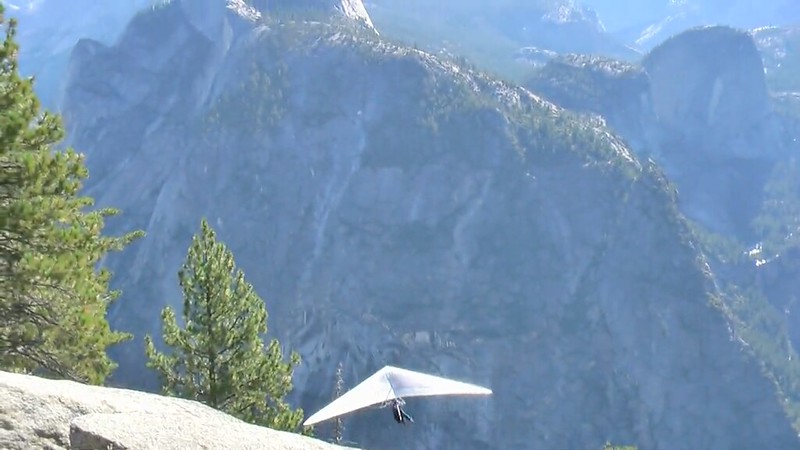

http://farm4.staticflickr.com/3935/15493716721_dde8c73f48_o.png
19-817
...and half kills himself there are scores of calls to take a chainsaw to it but when a crappy pilot like Bryan Bowker blows a weak link...
http://www.youtube.com/watch?v=VYe3YmdIQTM
...and breaks his arm into four pieces the calls for beefing up the piece of fishing line to something sustainable are virtually nonexistent.
This is why you should roll the glider and push out as soon and hard as possible to blow the weak link and thus terminate the lockout as soon as possible.Lockouts only matter near the ground (at altitude, the weak link, no matter how strong it is, will break and the glider recover if the pilot doesn't release). If a lockout occurs near the ground, you do not want to rely on any weak link to save you. If it's strong enough to get you to altitude, it's strong enough to permit a very bad attitude that could be catastrophic near the ground (as illustrated by the earlier video I posted)....a weak link that is weak enough to break during lockout...
Depends a lot on...That's why they say the weak link isn't there to protect the pilot.
...which they you're listening to.Towing Aloft - 1998/01
Speed controlled towing is when the speed of the device doing the towing is maintained at a reasonably constant value. Controls, such as throttle, are used to keep the speed of the tow vehicle or tow winch operating at a constant speed. Towline tension can vary dramatically in response to thermals, sink, pilot corrections, etc. Aerotowing is clearly in this category as the tug needs to maintain a minimum speed to prevent stalling. Many of the early towing efforts of the '70s where the vehicle drove at a fixed speed would also fall into this category. Weak links very clearly will provide protection from excessive angles of attack, high bank turns and the like for this form of towing.
Not necessarily. You can be climbing while progressing into a lockout. Then the math's gonna get a bit tricky.For any given lockout that ends in a weak link break, there's a breaking altitude below which the pilot will not be able to prevent a crash. If you use a stronger weak link, that altitude will be a little higher.
And let's not forget that there are THREE ways a lockout can be terminated.
- Release actuation is always the fastest and produces the most satisfactory results - provided, of course, that the person flying the glider isn't stupid enough to get on the cart with a release that stinks on ice.
- Weak link failure works OK - for those with the luxury of adequate altitude.
- Imact with the surface can often do the job a lot faster than the weak link. The weak link WILL blow at that point - and there's no nasty stall to worry about afterwards.
There's no law of physics which states that a weak link of any rating high enough to get a glider airborne has gotta blow before the glider slams in. Debbie Young, Robin Strid, and Steve Elliot have all demonstrated that pretty conclusively.
http://ozreport.com/forum/viewtopic.php?t=24846Using the weaker weak link will only matter if the lockout occurs between those two altitudes, so you'd basically be gambling that at some point you'll need it to break in this range in exchange for a much greater chance of it breaking at a bad time.
Is this a joke ?
250 feet is the generally accepted minimal survival altitude for Industry Standard equipment.Marc Fink - 2011/08/28 21:11:09 UTC
The weaklink blew and the glider stalled--needed every bit of the 250 ft agl to speed up and pull out. I'm alive because I didn't use a stronger one.
The really anal pilot who desires to survive lockouts below that figure has two options...Marc Fink - 2011/08/31 08:11:05 UTC
This all happened in a few seconds. I was actually in the process of reaching for the release and just about to pull it when the weaklink blew. If procedures were amended to "insist" on stronger weaklinks I would simply stop towing.
- A hundred pound test loop of fishing line will limit lockout recovery altitude to a maximum of 192 feet and allow one to get to release altitude about one out of four attempts.
- After a good Cone of Safety training course the pilot will understand that if he stays within twenty degrees of straight behind the tug he will be immune to lockouts.
There are a few wack jobs who advocate using equipment that doesn't require a few seconds and a reach to blow oneself off tow but none of it is Industry Standard with a huge track record and all if it is completely untested and very experimental gear which will likely fail in new and unforeseen ways as it tries its damnedest to kill you.
Fuck you.Jim Gaar - 2012/08/17 22:12:29 UTC
This is GOLDEN for all of us that tow (I tow a lot on a PL rig). It holds true for ANY towing system. Zack you are doing a great job of shining the light on the weaklink issues. It's really that simple to me. I am going to start using 205 leech. I was using 4 strands of 130 kite string (standard AT stuff). Thanks
C'mon Zack...Zack C - 2012/08/17 23:25:41 UTCThe purpose of the weak link is the same for any tow method, but what you quoted is not entirely applicable to payout winch towing because it's tension controlled. While a weak link will eventually break at some point in the course of an aerotow lockout, this is generally not the case on a payout winch because the drum will just pay out faster rather than allow tension to increase. It thus makes even less sense to use lighter weak links with payout winch towing.It holds true for ANY towing system.
http://www.hanggliding.org/viewtopic.php?t=18868
Almost lockout
It'll break.Ryan Voight - 2010/09/07 02:50:00 UTC
Weak link in truck towing WILL (read: should) still break in a lockout situation... but as everyone has already pointed out, it takes a lot longer because the glider can continue to pull line off the winch.
There is a limit to how fast line can come off the winch though... so the forces still build up, and the weaklink still fails.
http://ozreport.com/forum/viewtopic.php?t=24846
Is this a joke ?
(It always amazes to hear know it all weekend warriors arguing with the professional pilots.)Jim Rooney - 2011/08/25 04:55:25 UTC
It always amazes to hear know it all pilots arguing with the professional pilots.
I got more than a few problems with that asshole.For AT or PL? How many strands of 205? At the end of a V bridle or directly engaging the towline?I am going to start using 205 leech. I was using 4 strands of 130 kite string (standard AT stuff).
Four strands of 130 will break around 200 lbs (not the 520 often assumed).
Here in Houston we use four strands (two loops) of 205 leech line directly engaging the towline for platform towing. We've tested this configuration to break around 600 lbs.No problem.Thanks
Paul Edwards - 2012/08/18 00:55:41 UTC
Thanks Zack! That clarifies it well.
Tad Eareckson - 2012/03/13 21:06:14 UTCOoh! Somebody likes Zack! (I wonder what it's like to be liked by a Jack Show diver.)Paul Edwards - 2012/03/13 12:25:45 UTC
Plus it'd be great to fly together again.
Maybe Zack can get through to him on something and get him to pass it on to someone else.
Seems like a very subtle difference to raise such ire.
Dr. Trisa Tilletti 1 - 2012/06
Unlike the FAA's relatively clear-cut legal rules, the practical aspects of weak link technology and application are not so clear-cut. For some people, talking about weak links is more like talking about religion, politics, or global warming--they can get very emotional about it and have difficulty discussing it logically, rationally, or with civility.
http://www.hanggliding.org/viewtopic.php?t=26302Dr. Trisa Tilletti 2 - 2012/06
So let's try to talk about it rationally, logically, and practically here.
HIGHER EDUCATION ?
The ire arises from over three decades of operating under Donnell Hewett's lunatic assumptions and pronouncements about the "purposes" of and parameters for the weak link, the incompetence and lying involved in perpetuating said lunacy, and the waste and carnage which has resulted.NMERider - 2012/06/06 03:25:09 UTC
You are being much too complimentary IMHO. I got so nauseated reading it I had to take a breather. Do you mean to tell me they wrote an article that wasn't insipid and self-congratulatory to the extreme? I've found their entire series on aerotowing to come off rather poorly to say the least. A sad waste of such exalted and highly qualified medical professionals. How do I know this? Well they won't stop patting each other on the back about how great they both are. Pardon me while I puke.
Fuck that. REAL pilots don't have COMFORT levels with respect to weak links, parachutes, or unhooked launch recovery procedures. You need any, some, or all of the above, you've screwed one or more pooches and you're REAL fucking uncomfortable - and you're life expectancy at that point may be REAL short.Either way unplanned breaks are possible. Either way the weak link will pop long before the aircraft does. It just comes down to a matter of degree... And which set of variables a pilot is most comfortable towing with.
http://www.aviationbanter.com/archive/index.php/t-40965.html
Are Weak Links really Necessary for Aero Tow?
Sailplane owner's manuals specify the weak link appropriate for the particular glider - and they don't say anything about the idiot pilot's goddam comfort level or its length.Bill Daniels - 2006/09/18 14:30
Actually, reading the Pilot's Operating Handbook for several German gliders, I note the weak link for aerotow is specified as an exact figure. For example, the weak link for both aero tow and winch for my Nimbus 2C is specified as 600 KG (1323 Lbs) or a blue Tost weak link.
All four of them.Zack C - 2012/08/18 01:16:26 UTC
I suspect nearly all pilots using a good release...
Which is to use a 260 pound loop of 130 pound Greenspot rather than a 130 pound loop of 130 pound Greenspot....and following USHPA's weak link recommendation...
Only if they also use fins and have had tandem Cone of Safety training....will never see a weak link break - just as in the sailplane world.

